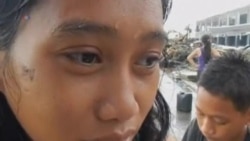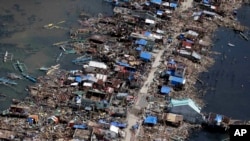MANILA/WASHINGTON —
Survivors of a typhoon that slammed the central Philippines on Friday have become increasingly desperate, looting shops and aid convoys in search of food and water.
Local authorities said they believe up to 10,000 people were killed on the central islands of Leyte and Samar, where Haiyan became one of the world's strongest cyclones on record to make landfall. Many drowned when tsunami-like waves swept through island communities.
Officials on Samar island said at least 300 people are confirmed dead, with another 2,000 missing.
The Philippine government said its official death toll was 229 late Sunday, but it has acknowledged the figure is likely to increase substantially.
After going without food for three days, some residents of Leyte's capital, Tacloban, resorted to ransacking the remains of stores and homes in the devastated city of 200,000 people.
Looters also raided delivery vans carrying humanitarian aid, but other residents lined up peacefully as Philippine soldiers handed out supplies.
Thousands of homes were reduced to rubble, while crumpled cars lay smashed into each other and splintered trees and power lines clogged the muddy ground.
Haiyan created a five-meter high storm surge that pounded Tacloban and left bodies tossed about in its wake. Authorities struggled to retrieve them.
Food takes priority
Philippine Red Cross chief Gwendolyn Pang said her organization has ordered body bags, but is focussed on delivering 45,000 food packs to the families most in need.
"People are impatient already because they want to see significant support already, since today is already the third day since the typhoon," said Pang.
She said managing the crisis is an overwhelming challenge, even with some roads partially cleared. Aid workers trying to bring in food and water supplies struggled to communicate with each other.
Related photo gallery
Philippines President Benigno Aquino toured Tacloban and other hard-hit areas on Sunday. He said his government's priority is to deliver relief and medical assistance to survivors and restore power and communications in isolated areas.
In contrast to scenes of looting shown on television, the president's social media account posted photographs of Tacloban residents waiting for relief goods with a caption saying they lined up in an "orderly" manner. Vice President Jejomar Binay also visited one island and called the typhoon a "national tragedy."
Foreign aid efforts
The U.N. Humanitarian Coordinator Office in Manila said aid workers have "ramped up critical relief operations" in the affected region. But it said "access remains a key challenge," as some areas are still cut off from supplies.
The U.N. World Food Program said it was working with the Philippine government to fly food, logistics and communications equipment to Cebu island, southwest of Leyte. It said Cebu airport will become a key hub for airlifts to Tacloban, whose airport was badly damaged and closed to all but military aircraft.
Aid group Doctors Without Borders said it is sending dozens of medical personnel and logisticians to Cebu in the coming days, along with 200 tons of medical and relief items. But, the group said it has not been able to fully assess the needs of typhoon survivors because access to affected areas is "extremely difficult."
The United States helped with the relief effort. In a Saturday statement, the Defense Department said the U.S. Pacific Command will assist in search and rescue operations and aircraft support.
A relief team from the U.S. Agency for International Development (USAID) also was deployed to conduct damage assessments, track conditions and "advise on additional needs."
Electricity challenge highlighted
The storm-battered central Philippine provinces were facing more problems with fallen cell towers and multiple power outages. And some places like Leyte were completely in the dark.
Philippine National Police chief superintendent Vic Loot flew from Manila to Cebu on Saturday to check on his home in Daan Bantayan. He said he spent five hours working with emergency responders to cut through fallen trees and electric poles with chainsaws just to get inside the town.
Loot said Daan Bantayan is Leyte's main connection to the national power grid.
"That is a very crucial point," he said, "And we need the roads there for the technicians to come, for the repairmen ... the area should be cleared."
Loot said that part of the grid should be prioritized so that power can be restored within 30 days, otherwise it could take about three months.
He said nearly every home in the town of 75,000 was severely damaged, including his own.
At the Vatican, Pope Francis used his weekly Angelus prayer to urge the faithful to pray in silence for the typhoon's victims. He said he feels close to the Philippine people and urged his listeners to send "concrete" assistance to them. The Philippines has the biggest Roman Catholic population in Asia.
Weather agencies said Typhoon Haiyan was expected to hit northern Vietnam early Monday after moving northwest through the Gulf of Tonkin. On Sunday, the storm dumped heavy rain on southern China's Hainan island to the east, forcing authorities to cancel flights.
Courtesy Taiwan Central Weather Bureau
(Orendain reported from Manila and Lipin contributed from Washington.)
Local authorities said they believe up to 10,000 people were killed on the central islands of Leyte and Samar, where Haiyan became one of the world's strongest cyclones on record to make landfall. Many drowned when tsunami-like waves swept through island communities.
Officials on Samar island said at least 300 people are confirmed dead, with another 2,000 missing.
The Philippine government said its official death toll was 229 late Sunday, but it has acknowledged the figure is likely to increase substantially.
After going without food for three days, some residents of Leyte's capital, Tacloban, resorted to ransacking the remains of stores and homes in the devastated city of 200,000 people.
Looters also raided delivery vans carrying humanitarian aid, but other residents lined up peacefully as Philippine soldiers handed out supplies.
Thousands of homes were reduced to rubble, while crumpled cars lay smashed into each other and splintered trees and power lines clogged the muddy ground.
Haiyan created a five-meter high storm surge that pounded Tacloban and left bodies tossed about in its wake. Authorities struggled to retrieve them.
Food takes priority
Philippine Red Cross chief Gwendolyn Pang said her organization has ordered body bags, but is focussed on delivering 45,000 food packs to the families most in need.
"People are impatient already because they want to see significant support already, since today is already the third day since the typhoon," said Pang.
She said managing the crisis is an overwhelming challenge, even with some roads partially cleared. Aid workers trying to bring in food and water supplies struggled to communicate with each other.
Related photo gallery
Philippines President Benigno Aquino toured Tacloban and other hard-hit areas on Sunday. He said his government's priority is to deliver relief and medical assistance to survivors and restore power and communications in isolated areas.
In contrast to scenes of looting shown on television, the president's social media account posted photographs of Tacloban residents waiting for relief goods with a caption saying they lined up in an "orderly" manner. Vice President Jejomar Binay also visited one island and called the typhoon a "national tragedy."
Foreign aid efforts
The U.N. Humanitarian Coordinator Office in Manila said aid workers have "ramped up critical relief operations" in the affected region. But it said "access remains a key challenge," as some areas are still cut off from supplies.
The U.N. World Food Program said it was working with the Philippine government to fly food, logistics and communications equipment to Cebu island, southwest of Leyte. It said Cebu airport will become a key hub for airlifts to Tacloban, whose airport was badly damaged and closed to all but military aircraft.
Aid group Doctors Without Borders said it is sending dozens of medical personnel and logisticians to Cebu in the coming days, along with 200 tons of medical and relief items. But, the group said it has not been able to fully assess the needs of typhoon survivors because access to affected areas is "extremely difficult."
The United States helped with the relief effort. In a Saturday statement, the Defense Department said the U.S. Pacific Command will assist in search and rescue operations and aircraft support.
A relief team from the U.S. Agency for International Development (USAID) also was deployed to conduct damage assessments, track conditions and "advise on additional needs."
Electricity challenge highlighted
The storm-battered central Philippine provinces were facing more problems with fallen cell towers and multiple power outages. And some places like Leyte were completely in the dark.
Philippine National Police chief superintendent Vic Loot flew from Manila to Cebu on Saturday to check on his home in Daan Bantayan. He said he spent five hours working with emergency responders to cut through fallen trees and electric poles with chainsaws just to get inside the town.
Loot said Daan Bantayan is Leyte's main connection to the national power grid.
"That is a very crucial point," he said, "And we need the roads there for the technicians to come, for the repairmen ... the area should be cleared."
Loot said that part of the grid should be prioritized so that power can be restored within 30 days, otherwise it could take about three months.
He said nearly every home in the town of 75,000 was severely damaged, including his own.
At the Vatican, Pope Francis used his weekly Angelus prayer to urge the faithful to pray in silence for the typhoon's victims. He said he feels close to the Philippine people and urged his listeners to send "concrete" assistance to them. The Philippines has the biggest Roman Catholic population in Asia.
Weather agencies said Typhoon Haiyan was expected to hit northern Vietnam early Monday after moving northwest through the Gulf of Tonkin. On Sunday, the storm dumped heavy rain on southern China's Hainan island to the east, forcing authorities to cancel flights.
Courtesy Taiwan Central Weather Bureau
(Orendain reported from Manila and Lipin contributed from Washington.)













